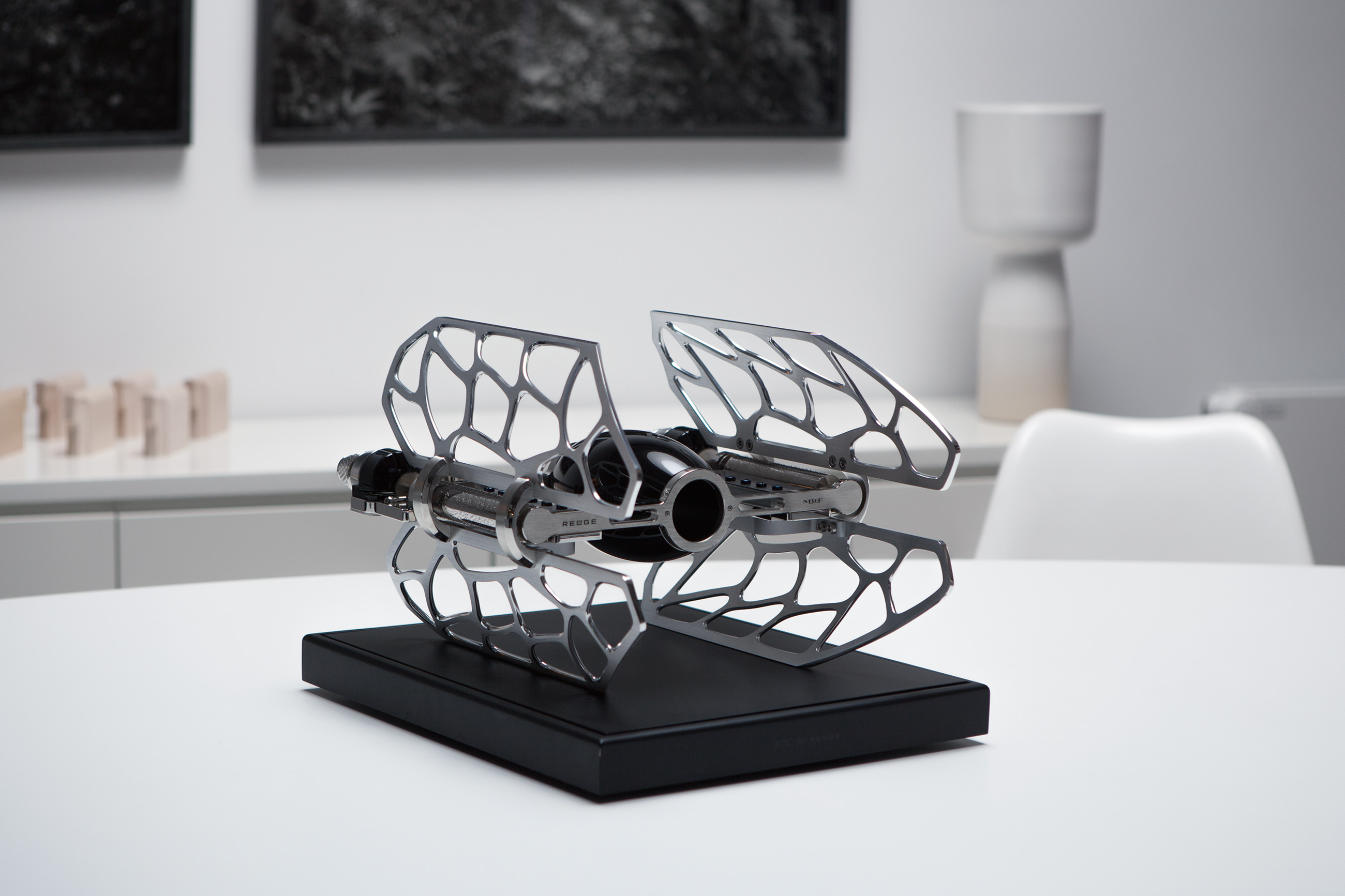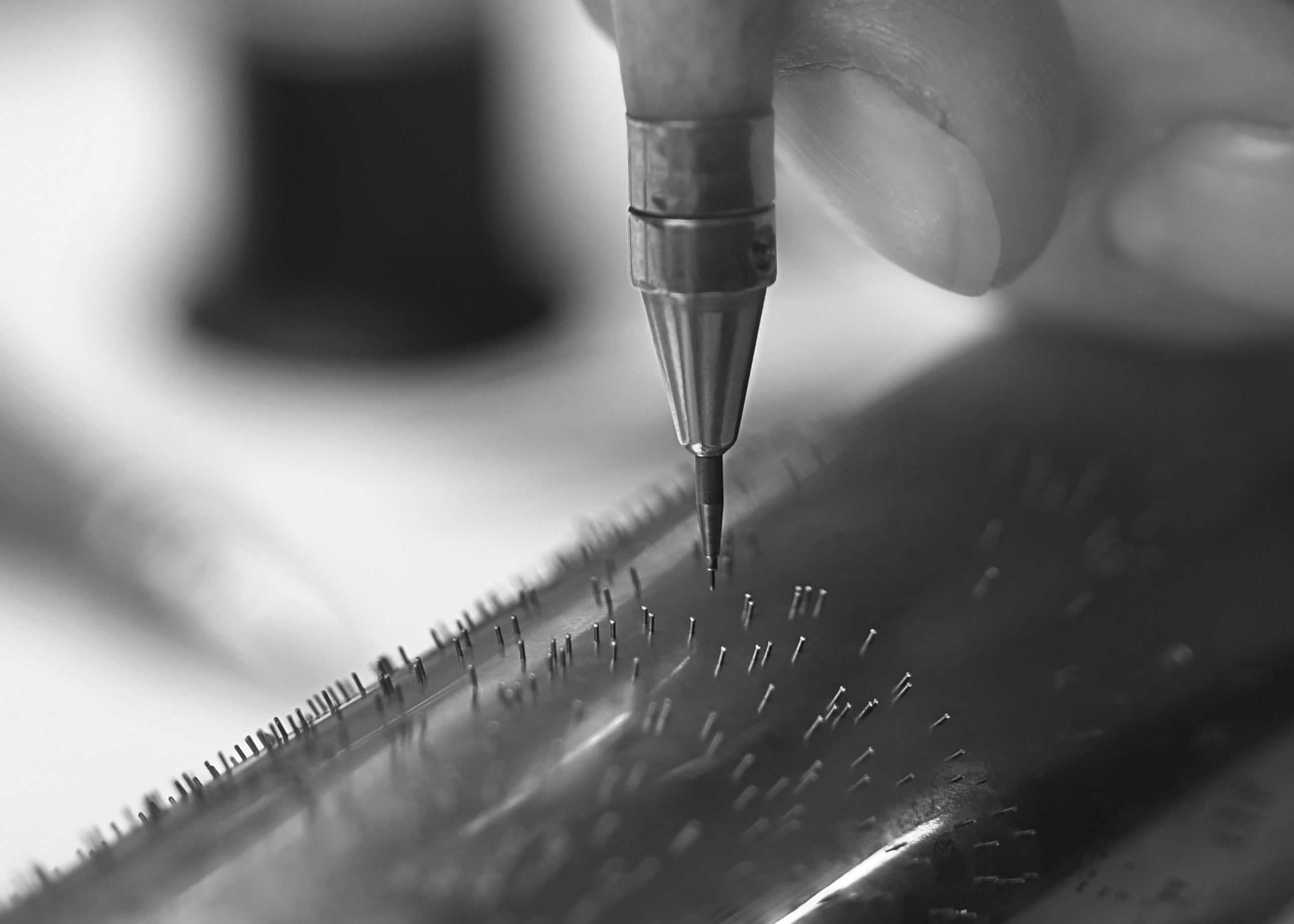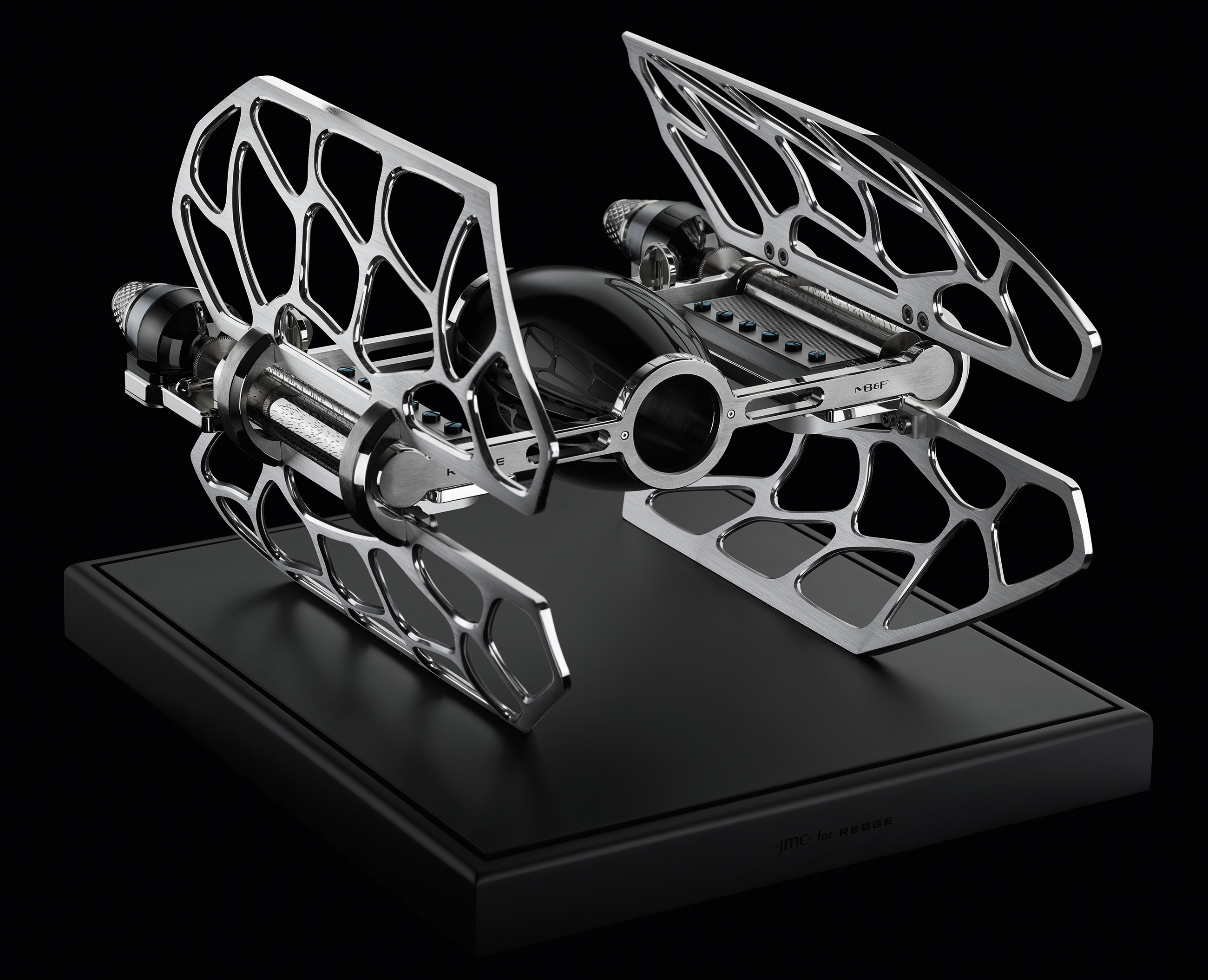SUMMARY
MB&F celebrates its tenth anniversary in 2015 with the tagline “A creative adult is a child who survived.” One lm that children (and many adults) of all ages love is Star Wars and who could forget the frantic swarms of the Imperial eet’s TIE ghters as they battle the Alliance. The TIE ghter- inspired MusicMachine 3 (MM3) is proof positive that both the child and the Force are still going strong within MB&F founder Maximilian Büsser – who was 10 years old when he rst saw Star Wars in 1977.[wpvideo kfgv9L3O] ] ] ] ]<<<< e MusicMachine 3 may look as though it is more at home darting around in the silent vacuum of space, it is in the sound-propagating, air-rich atmosphere of Earth in which MM3 really displays its mettle. Those lattice-like vertical wings support and protect the dual music cylinders, each playing three melodies: the theme tunes from Star Wars, Mission Impossible, and James Bond on the right and The Godfather, Merry Christmas Mr. Lawrence, and The Persuaders on the left. Those side wings also play a vital role in propagating sound vibrations down from the combs to the naturally amplifying resonant base, manufactured by JMC Lutherie.
 <<<<
ay appear to come from a galaxy far, far away in the future; however, its origins are much older and much closer to home. MusicMachine 3 features all of the traditional elements of a beautifully arranged, high-end mechanical music box. This should come as no surprise as it was developed and crafted according to MB&F’s design by Reuge, the Swiss music box manufacturer with 150 years of expertise and experience.
The music in MusicMachine 3 is powered by two independent movements mounted on the two tail sections. Each movement has its own winding key (disguised as thrusters), a mainspring barrel, a horizontal cylinder with pins, and comb with hand-tuned teeth sounding each note. The cylinders play three melodies each. An air regulator in the form of a circular fan (resembling a rotating radar dish) governs the unwinding speed/music tempo of each cylinder.
To ensure the lateral symmetry of MM3, Reuge broke with music box convention to configure the two movements as mirror images of one another. This required a complete inversion of the design of the movement components and the movement architecture so that one cylinder rotates clockwise and the other anticlockwise.
<<<<
ay appear to come from a galaxy far, far away in the future; however, its origins are much older and much closer to home. MusicMachine 3 features all of the traditional elements of a beautifully arranged, high-end mechanical music box. This should come as no surprise as it was developed and crafted according to MB&F’s design by Reuge, the Swiss music box manufacturer with 150 years of expertise and experience.
The music in MusicMachine 3 is powered by two independent movements mounted on the two tail sections. Each movement has its own winding key (disguised as thrusters), a mainspring barrel, a horizontal cylinder with pins, and comb with hand-tuned teeth sounding each note. The cylinders play three melodies each. An air regulator in the form of a circular fan (resembling a rotating radar dish) governs the unwinding speed/music tempo of each cylinder.
To ensure the lateral symmetry of MM3, Reuge broke with music box convention to configure the two movements as mirror images of one another. This required a complete inversion of the design of the movement components and the movement architecture so that one cylinder rotates clockwise and the other anticlockwise.
 <<<<
cMachine 3 doesn’t just look as though it has own in from a more advanced civilization, it sounds like it as well. The majority of music boxes amplify sound through their wooden cases, much like guitars and violins do. MM3 is carefully designed to transmit the musical vibrations from the combs down through the two vertical side wings to its resonance base. This natural timber amplifier was developed by Jeanmichel Capt of JMC Lutherie, based in the Vallée de Joux, in the heart of Switzerland’s horological landscape.
MusicMachine 3 is a limited edition of 99 pieces: 33 pieces with white finish; 33 pieces with black finish; and 33 pieces with ‘chrome’ finish.
MUSICMACHINES MUSIC BOXES FOR THE 25TH CENTURY Mechanical music boxes produce melodies by way of tuned teeth on a steel comb being plucked by pins on a revolving cylinder. Music box movements share many similarities with their horological counterparts, both technically and aesthetically: Energy derived from a coiled spring is transferred by a gear train, with the unwinding speed carefully regulated by a precision fan (similar to many minute-repeater regulators). High-end music box components are evenly finished similarly to high-end watch movements.nce music boxes first appeared in the early 19th century, Switzerland, the home of fine watchmaking, became the hub of high-quality music box production. In 1865, Charles Reuge was a pioneer of the genre when he set up his first musical pocket watch shop in Sainte-Croix, located in the Jura mountains home of many legendary watches.arly 150 years on, and still in Sainte-Croix, Reuge is the only remaining manufacturer of high-end music boxes in the world. Reuge’s collection has grown to offer both quintessentially classical pieces and contemporary designs – including a service for specially commissioned bespoke pieces. With the MB&F MusicMachines, Reuge has pushed the frontiers of music box design: MusicMachines belong more to the 25th century than the 21st!
<<<<
cMachine 3 doesn’t just look as though it has own in from a more advanced civilization, it sounds like it as well. The majority of music boxes amplify sound through their wooden cases, much like guitars and violins do. MM3 is carefully designed to transmit the musical vibrations from the combs down through the two vertical side wings to its resonance base. This natural timber amplifier was developed by Jeanmichel Capt of JMC Lutherie, based in the Vallée de Joux, in the heart of Switzerland’s horological landscape.
MusicMachine 3 is a limited edition of 99 pieces: 33 pieces with white finish; 33 pieces with black finish; and 33 pieces with ‘chrome’ finish.
MUSICMACHINES MUSIC BOXES FOR THE 25TH CENTURY Mechanical music boxes produce melodies by way of tuned teeth on a steel comb being plucked by pins on a revolving cylinder. Music box movements share many similarities with their horological counterparts, both technically and aesthetically: Energy derived from a coiled spring is transferred by a gear train, with the unwinding speed carefully regulated by a precision fan (similar to many minute-repeater regulators). High-end music box components are evenly finished similarly to high-end watch movements.nce music boxes first appeared in the early 19th century, Switzerland, the home of fine watchmaking, became the hub of high-quality music box production. In 1865, Charles Reuge was a pioneer of the genre when he set up his first musical pocket watch shop in Sainte-Croix, located in the Jura mountains home of many legendary watches.arly 150 years on, and still in Sainte-Croix, Reuge is the only remaining manufacturer of high-end music boxes in the world. Reuge’s collection has grown to offer both quintessentially classical pieces and contemporary designs – including a service for specially commissioned bespoke pieces. With the MB&F MusicMachines, Reuge has pushed the frontiers of music box design: MusicMachines belong more to the 25th century than the 21st!
 Designed by MB&F and made by Reuge, the rst MusicMachine was launched at Baselworld 2013. Building on the success of this initial collaboration, Reuge and MB&F joined forces in 2014 for MusicMachine 2 and again in 2015 for MusicMachine 3, which completes the trilogy.
Designed by MB&F and made by Reuge, the rst MusicMachine was launched at Baselworld 2013. Building on the success of this initial collaboration, Reuge and MB&F joined forces in 2014 for MusicMachine 2 and again in 2015 for MusicMachine 3, which completes the trilogy.
MUSICMACHINE 3’S SCI-FI DESIGN Reuge created MusicMachine 3 based on the Star Wars TIE ghter design proposed by MB&F and designer Xin Wang. The concept cleverly incorporates all of the essential music box features – musically tuned combs, pinned cylinders, winding mechanisms, mainspring barrels, and regulators – into a TIE ghter-style music machine. To optimise and amplify the sound created by MusicMachine 3, Jeanmichel Capt of JMC Lutherie developed MM3’s ingenious resonance base.
THE MELODIES While the look of MusicMachine 3 is very much Star Wars, its music is set in the epoch of the lms and TV series of Büsser’s childhood: the 1960s and 70s. The right cylinder plays themes from Star Wars (1977), Mission Impossible (1960), and James Bond (1962), while the left plays themes from The Godfather (1972) by Nino Rota, Merry Christmas, Mr. Lawrence (1983) by Ryuichi Sakamoto, and The Persuaders (1971) by John Barry.
 MECHANICALLY RECREATING MUSIC Once MB&F con rmed the melodies, a Reuge musician examined the tunes and identi ed the most recognisable passages from each. Work then began on recreating the music, keeping in mind that one cylinder contains the three melodies, while the other contains three other tunes, and that each cylinder’s pins plucks all of the notes from one 72- note comb.
MECHANICALLY RECREATING MUSIC Once MB&F con rmed the melodies, a Reuge musician examined the tunes and identi ed the most recognisable passages from each. Work then began on recreating the music, keeping in mind that one cylinder contains the three melodies, while the other contains three other tunes, and that each cylinder’s pins plucks all of the notes from one 72- note comb.
Working out these two groups of three arrangements, each one around 35 seconds, and the multitude of notes that these entail – some notes are used by all three melodies, some notes are exclusive to just one melody – represents a considerable technical and artistic achievement in which the musician’s instinct tops any computer.
MUSICMACHINE3’S ENGINE ROOM The music box movements – containing combs, cylinders, winding mechanisms, mainspring barrels, and regulators – are xed to two Geneva wave-decorated main plates (one each side) running from the “thruster” winders at the back to the front of the music cylinders.
 THE COMBS The two combs lie at beside each cylinder, each forming a unique pair containing the bespoke selection of 72 notes. The combs are hand-tuned from a unique steel alloy selected for its acoustic impact. For bass notes, the tooth is thickened by the traditional method of adding lead. A machine then tests the frequency of each tooth, and slivers of material are removed to accurately tune each note. The hand-operated tools that Reuge uses in this process have been developed in-house. Tiny transparent, synthetic feathers are added behind the bass note teeth, acting as dampers. Once the comb is attached to the main plate using heat-blued screws, the musician’s ear is required again for the concluding ne- tune!
THE COMBS The two combs lie at beside each cylinder, each forming a unique pair containing the bespoke selection of 72 notes. The combs are hand-tuned from a unique steel alloy selected for its acoustic impact. For bass notes, the tooth is thickened by the traditional method of adding lead. A machine then tests the frequency of each tooth, and slivers of material are removed to accurately tune each note. The hand-operated tools that Reuge uses in this process have been developed in-house. Tiny transparent, synthetic feathers are added behind the bass note teeth, acting as dampers. Once the comb is attached to the main plate using heat-blued screws, the musician’s ear is required again for the concluding ne- tune!
 THE CYLINDERS The beautifully hand- nished cylinders gleam like a pair of imposing power reactors. The cylinders essentially contain the melodies’ ‘scores’, with as many as 1,400 precision- placed pins plucking the teeth of the comb as the cylinder revolves.
THE CYLINDERS The beautifully hand- nished cylinders gleam like a pair of imposing power reactors. The cylinders essentially contain the melodies’ ‘scores’, with as many as 1,400 precision- placed pins plucking the teeth of the comb as the cylinder revolves.
WINDING KEYS AND MAINSPRING BARRELS Frustums (truncated cones) resembling propulsion thrusters on each side of the tail section are actually winding keys that are linear with the mainspring barrels and cylinders. This is an unconventional con guration for music boxes, but MB&F’s daring design dictated it. One additional advantage is that the linear con guration allows a more ef cient transfer of energy. These winding keys – a challenge for Reuge’s team to get just right – revolve as the barrels unwind and the cylinders turn.
FAN REGULATORS In the centre of the main plate are distinctive vertical circular panels. While these might look as though they could be radar dishes used for navigating an asteroid eld, they are actually the cylinder speed regulators. When fully wound, the mainsprings have more torque so they tend to rotate the cylinders faster than when nearly unwound. To compensate, these circular fan air regulators provide exponentially more resistance when rotating faster than slower, allowing for a more constant revolution. A similar system is found in many minute-repeater watches.
 RESONANT BASE PRINCIPLES Functioning by the principle of forced vibration, wooden soundboards traditionally feature on stringed instruments such as violins, guitars and pianos. The board is vibrated by the string at the same frequency, producing the same sound, the only difference being the timbre. While the same amount of energy is created irrespective of the board’s presence, a soundboard is more able to transform this energy into sound because of its greater surface area – the board can move a greater volume of air – creating a louder sound. On MusicMachine 3, energy is transmitted from the vibrating teeth down though the vertical side wings to the resonance base, which not only ampli es the sound, but underlines the beauty of the music. MusicMachine 3’s innovative base combines 350-year-old resonance spruce with 21st century composite materials like NomexTM honeycomb Kevlar.
RESONANT BASE PRINCIPLES Functioning by the principle of forced vibration, wooden soundboards traditionally feature on stringed instruments such as violins, guitars and pianos. The board is vibrated by the string at the same frequency, producing the same sound, the only difference being the timbre. While the same amount of energy is created irrespective of the board’s presence, a soundboard is more able to transform this energy into sound because of its greater surface area – the board can move a greater volume of air – creating a louder sound. On MusicMachine 3, energy is transmitted from the vibrating teeth down though the vertical side wings to the resonance base, which not only ampli es the sound, but underlines the beauty of the music. MusicMachine 3’s innovative base combines 350-year-old resonance spruce with 21st century composite materials like NomexTM honeycomb Kevlar.
 350-YEAR-OLD RESONANCE SPRUCE MusicMachine 3’s soundboard base features timber from 350-year-old resonance spruce from the Risoud Forest in Switzerland, where cool summers and cold winters lead
350-YEAR-OLD RESONANCE SPRUCE MusicMachine 3’s soundboard base features timber from 350-year-old resonance spruce from the Risoud Forest in Switzerland, where cool summers and cold winters lead
MM3





… [Trackback]
[…] Find More Info here to that Topic: cronotempvscollectors.com/mb-f-musicmachine-3/ […]
… [Trackback]
[…] Read More on that Topic: cronotempvscollectors.com/mb-f-musicmachine-3/ […]
… [Trackback]
[…] Information to that Topic: cronotempvscollectors.com/mb-f-musicmachine-3/ […]